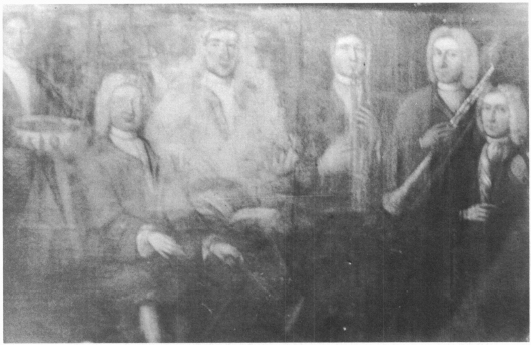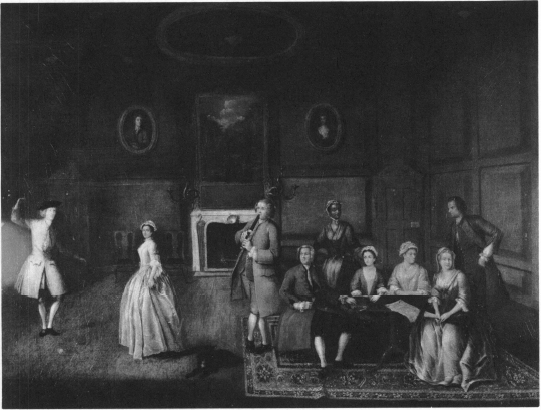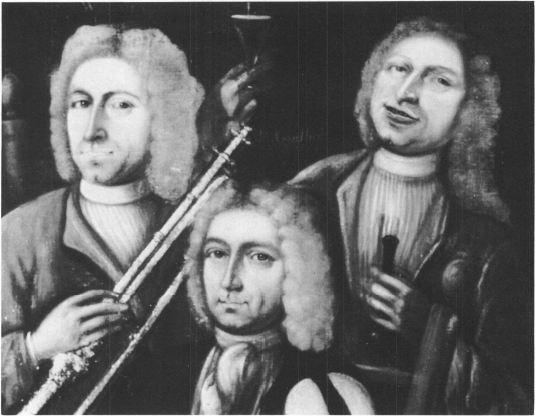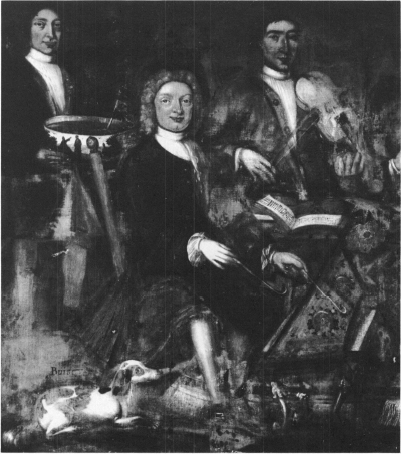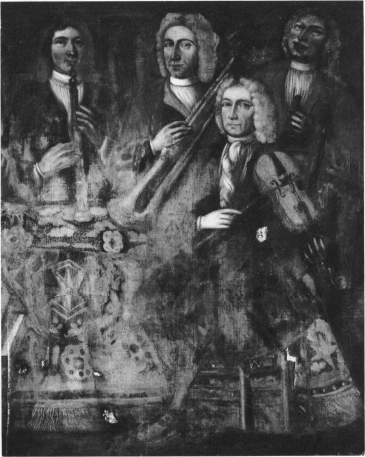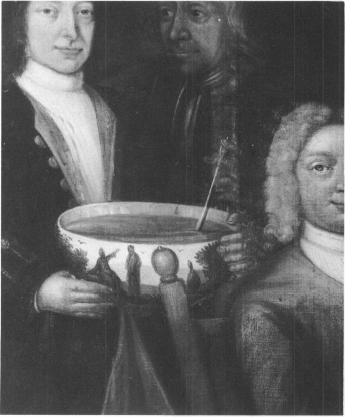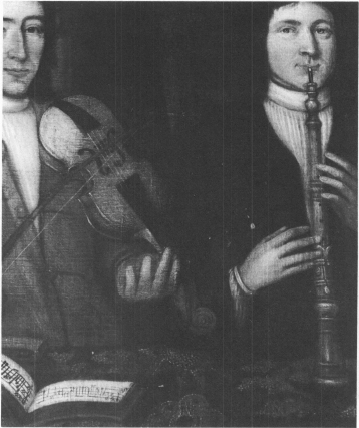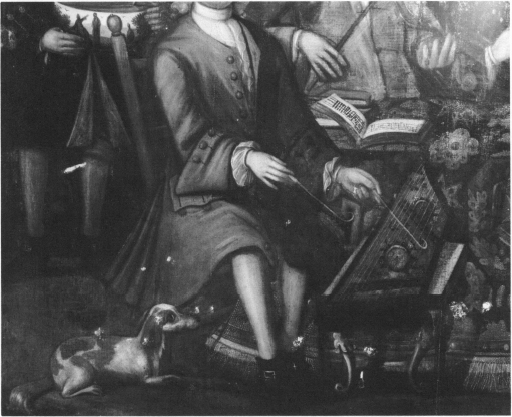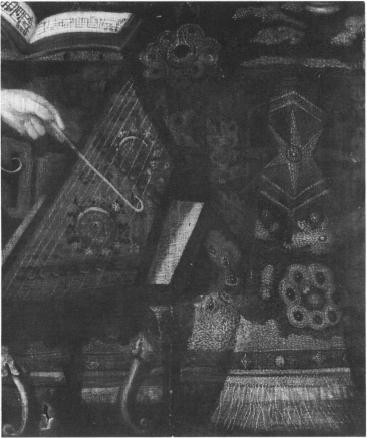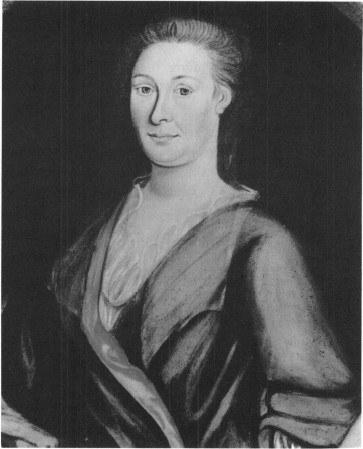A Musical Gathering: Investigative Steps and Preliminary Conjectures
A RECENTLY discovered eighteenth-century group portrait, A Musical Gathering (fig. 277, see frontispiece), has aroused the interest and curiosity of connoisseurs of American music and painting. It depicts five life-size musicians seated around a turkey-carpeted table playing a dulcimer, an oboe, a trumpet, and two violins. Flanking them at either end are three companions holding a punch bowl, flask, and raised wine glass. In the care of the Nassau County Museum (Long Island) since the late 1960s, the painting presents not only a fascinating reflection of colonial-era musical activities, but also numerous questions as to its accurate identification, attribution, and historical placement. Investigative steps have had to consider matters of genealogy as well as stylistic qualities, cultural patterns, and the known traditions and details of art and music for the period. Since each figure has a name lettered in gold above his head, it has been necessary to test any hypotheses as to the painting’s origin against available corresponding genealogical information.
Like much of the painting’s color and detail, the names—Iõ. [Joseph] Rippingale; D. Wending; I. [?John] Elliston, Esqr; I. [?John] Hale; E. Low; W. Low; R. Godbolt; Ion. [Jonathan] Low; and the dog Buisey—were partially covered by encrusted dirt and varnish when the work first arrived at the museum (fig. 278). With some effort the general configuration of surnames could be read. First initials became clear only later with the aid of a conservator’s solvent and ultraviolet lamp (fig. 279).
Fig. 278. Detail from A Musical Gathering.
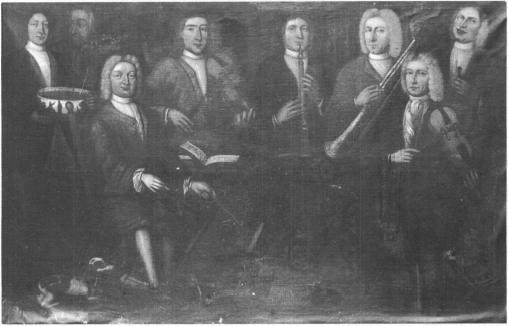
Fig. 279. A Musical Gathering after first dirt removal.
Also obscure was the full history of ownership. The painting can be traced back only to a former owner’s recollection of a rural property disposal auction in southeastern Connecticut, ca. 1929–1932,1 where the trail ends, despite attempts to work with sales notices, newspapers, and auctioneers of the period.
Early examination did yield the information that the paint support had been fashioned from four canvas strips, each approximately twenty-six inches wide, sewn together vertically. This conforms to the common portrait measure in the late seventeenth and early eighteenth centuries; thirty inches by twenty-five inches, a standard in England and America. The consistency of the four strips would lead one to believe that little of the original was lost at the side tacking edges.
The back to this cloth support was completely covered by a sturdy relining that seemed likely to date from the first part of the nineteenth century. Rabbit-skin glue was the adhesive. To learn whether the relining canvas could be hiding any marking that would lend specific direction to an identification investigation, our staff made X-ray photographs of the reverse. This step yielded no information, however.
In the early stages of the examination wood sample tests were performed by Gordon Salter of Winterthur. The stretcher (a late eighteenth- or early nineteenth-century type construction) was determined to be pinus strobus, or northeastern American white pine, while the colonial-period frame tested as “uncertain,” possibly American, or possibly the European pinus sylvestris, Scots pine.
Any scrutiny of 1930s’ art activities with regard to either portraiture of the colonial period or to eighteenth-century English conversation pieces2 quickly uncovers numerous instances of spurious sales to institutions and individuals of works that had just surfaced about that time with what were later found to be false names, signatures, and pedigrees.3
Fortunately in this case it was possible, again with the help of a conservationist and at a fairly early stage, to establish the validity of the lettered names as part of the original paint film, and also to determine that evidence of the gold pigment in the letters went down into the surface, far below the many layers of varnish and dirt.
Great caution is obviously required in speculating about the historical placement of an early eighteenth-century group painting that came to light in the way this one did. Yet if its origin proved to be American, it would be a very important addition to the knowledge of the country’s early art.
Its theme has no known counterpart in the New World. Indeed, as an American work it could well be regarded as the nation’s first genre painting. It would also have few known parallels in its size, 66½″ × 103½″, and in the fact that it is a group portrait. There are the Hesselius Last Supper, 1721–1722 (Fredericksburg, Virginia, Mrs. Rose Henderson Collection), commissioned for St. Barnabas Church, Queen Anne Parish, Maryland, which measures 35″ × 117½″; the two versions of the Smibert Dean Berkeley and His Entourage, 1730 (Dublin, National Gallery of Ireland Collection) and 1739 (New Haven, Yale University Art Gallery Collection), the later and larger version measuring 69½″ × 93″; the Feke Isaac Royall Family Portrait, 1741 (Cambridge, Harvard University Collection), 54⅝″ × 77¾″; and Greenwood’s Greenwood-Lee Family Portrait, ca. 1747 (Boston, Henry L. Shattuck Collection), 56″ × 68″. These and A Musical Gathering all have similar conceptions of figure placement and spacing.
Fig. 280. Family Group, a painting attributed to Charles Philips, England, ca. 1745.
There are ample instances of the use of the tradition in Western European art to supply thematic sources for A Musical Gathering. One of the Unicorn tapestries now in Paris provides a late fifteenth-century example of two figures at a carpeted table playing a harp. Seventeenth-century Dutch painters, including Terborch, Ochtervelt, and van Brekelenham, made numerous contributions to the tradition of depicting informal musical groups in settings that incorporate food, drink, and accessory figures. Seventeenth- and eighteenth-century Flanders produced musical groups painted by Jordaens, Hoemans, and others. All examples of such gatherings were, of course, part of the overall development of genre subjects.
English interest in the theme developed steadily through the seventeenth century and reached its peak in the conversation pieces of the eighteenth century. From the seventeenth century there are compositions by William Dobson to compare with A Musical Gathering, and from the eighteenth century there is the Family Group, attributed to Charles Philips who visited Williamsburg, Virginia, ca. 1740 (fig. 280).
Some of the English pictures, undoubtedly the direct inspiration for the painter of A Musical Gathering, could occasionally be quite large. William Whitley, in Artists and Their Friends in England, 1700–1799, reports that Philips had a work 12′ wide and 9′ high.4 Other sources, particularly those concerned with Hogarth’s career, report that conversation pictures did not pay adequately for the amount of work expended.5 Thus the ordinary commissions might go to a weaker artist, or actually be worked on by several painters. From earliest examples on, inclusion of a dog, as found here, is a favored device. Gold lettering on the canvas was not unusual within this tradition.
A number of English group portraits were produced during the early eighteenth-century era of clubs. George Vertue’s 1726 comment on a Smibert London work is of particular interest in tracing the stylistic convention. He described “one large piece being a Club of Virtuosi or a group of the Rosa-Coronians.”6
In the London of this period there were constant references to close ties between artists and musicians, which might have had a role in the background of A Musical Gathering. James Worsdale, one of Sir Godfrey Kneller’s apprentices, was also a musician. The portrait painter John Wollaston, Sr., was an amateur musician.7
The names might have resolved the major identification question, but they do not appear in any source for musicians in America or England known to this author.8 Moreover, nothing conclusive developed from a straight genealogical approach. The key surnames could be located in combination in the Boston area, in the Tidewater Virginia/North Carolina area, and in England, too. When the eighteenth-century given-name initials were uncovered beneath the varnish, Harriet Stryker-Rodda, a specialist in colonial handwriting problems, gave an informed interpretation of them. The additional information was not conclusive, however, in identifying the area in which the individuals lived.
Close scrutiny of style characteristics revealed in the faces, which had been kept comparatively clear of dried and encrusted old varnish, indicated that a technique of broad, coarse, direct brush strokes had been used. The academic approach in London and on the Continent at the time, however, was a method of gradually building up tone through successive glazes. While it is possible that a rural English portraitist might have worked in this direct brush technique, the absence of depth, the spacing of the figures, their scale with respect to the boundaries of the composition, and especially the proportioning and stiffness all seem sufficiently removed from London tradition and more likely to have occurred in an American colonial work.
Comments from specialists in eighteenth-century English art, and in English provincial work in particular, were valuable. The writer is grateful to Sir Oliver Millar, Surveyor of the Queen’s Pictures, to Mr. John Sunderland of the Courtauld Institute, and to Mr. John Kerslake of the National Portrait Gallery, who kindly examined slides and photographs. All suggested an American colonial attribution on the basis of the photographs, although Mr. Kerslake felt that it could also have been painted by a London primitive.
Additional reasons for pursuing the possibility of an American rather than an English origin included the accumulating physical evidence. Earlier, the laboratory test on the stretcher had shown the wood to be American. Then, when the painting went to Margaret Watherston’s studio for full restoration, impressions were taken of the four fabric strips which proved to be of four different weaves. This point strongly suggested that the artist had limited access to supplies of “painting cloths.” The colonies imported such supplies.
How could a painting like this be accounted for, and how does it correspond to known information about painting in America? Could it be explained as an actual musical event, and was the event so important as to warrant the large scale? Or, more likely, was the size the result of an intended decoration of a room for performances and dancing? Could there be an answer in an inscription hidden under the encrusted varnish or under the relining?
A considerable amount of time passed before the program for treatment and restoration was undertaken and during this interval some tentative hypotheses were tested. Since the large group portraits by Smibert, Feke, and Greenwood appeared to be the closest parallel in American art, the possibility of a Massachusetts origin was examined. The Massachusetts published records were studied for the surnames. That of Low was well known in the seventeenth and eighteenth centuries throughout the north shore county of Essex, Massachusetts, which includes the towns of Newbury, Ipswich, and Gloucester. Boston marriage records list an Edward Low in 1714 and a William Low in 1743. Boston birth records list a John, son of John Low, in 1729, and again in 1735. Another entry shows a John Low assigned to a Boston fire truck in 1748. Hale, too, appears often in Massachusetts colonial records. Godbolt does not occur but there are several entries with the spelling “Godbold.”9
A John Elliston is listed in Boston marriage records, 1695, and a John Elliston of Boston married Jane Hales of New Hampshire in 1721. Boston records also contain a reference to “the road by Elliston’s Corner” in 1708 and, as is often found in early records, a number of variations of the spelling of the name occur over the years: Elieston, Elletson, an Elieston in Sewall’s Diary, and Alisten, which is also a name in the Smibert record book for November 1734. The Smibert entry is for a kit-kat-size portrait (ca. 30″ × 25″) at nine guineas, however. Nothing conclusive could be determined from the “Esq.” appended to the Elliston of the group portrait. The title “Esquire” was used in reference to town officers as is demonstrated by Sewall’s Diary, and a G. Elliston was elected to a town office in Boston in 1700.10
As one might expect, nothing in the genealogical probings revealed any connection between the documented persons and musical activity. This absence made any line of speculation quite circumstantial.
That A Musical Gathering originated in Boston was further encouraged by the musical activity known to have taken place there. In Boston the early activity in dancing and the availability of imported instruments from the second decade of the eighteenth century are familiar. The earliest record to date of a concert in the New World took place in Boston in 1729, followed in 1731 by the well-known concert presented by Peter Pelham, whose principal career was as a painter and engraver. The musical activities of Thomas Johnston and William Price are well documented,11 and the interrelationships among painters, engravers, instrument makers, concert producers, dancing masters, and music publishers are especially interesting. This close creative circle included John Smibert as well as the artist friend of the Pelham family, John Greenwood, who was Johnston’s pupil.
Examples of all instruments in the painting are recorded as having been owned by Boston inhabitants as is evident from the table of musical instruments appearing in household inventories from the Probate Records of the Massachusetts counties of Suffolk and Middlesex from 1630 to the 1730s.12 The violin was a very common possession. Trumpets were owned by a number of persons and used for both official and purely musical purposes. The oboe and the dulcimer were both recorded in the eighteenth century. One must keep in mind, too, that the existing evidence is only a very small percentage of the actual documentation; much has long since vanished. One early documentation of a dulcimer in Massachusetts can be found in Samuel Sewall’s Diary for the year 1717: “[May] 23.5. To Salem, Meadford, Lodge at Cousin Porter’s: See and Hear the Dulcimer.”13
From the art point of view it was clear that Smibert could be considered as the likely importer of knowledge of the European tradition for painting the musical “genre” group, or conversation piece. Although there seemed to be certain stylistic parallels with Smibert’s Dean George Berkeley and His Family (fig. 281), particularly with regard to scale, figure placement, and brush stroke, overall comparisons with Smibert’s work were not as convincing as were those made with the work of John Greenwood. Certainly Greenwood was the one plausible colonial artist whose career left a record of innovation, imagination, and vigorous brush stroke. His Sea Captains Carousing at Surinam, 1752, is sometimes mentioned as America’s first genre scene.
Examination of the Greenwood paintings in the Essex Institute tended to confirm the stylistic parallels as well as a musical subject. Shortly afterwards Louisa Dresser, Curator of the Worcester Museum and a specialist in colonial portraiture, kindly made some helpful suggestions with regard to the investigation, and the correspondence that followed with the Society for the Preservation of New England Antiquities and its director, Abbott Lowell Cummings, was to bring the painting to the attention of Barbara Lambert, Keeper of Musical Instruments at the Museum of Fine Arts, Boston, as a rare cultural document in the field of music.
Although these investigative steps were valuable, there could be no completely valid answers without full knowledge of the painting surface as it would appear after cleaning. Indeed, while the treatment program was in progress, evidence was uncovered pointing to an earlier dating, one that would make Greenwood of the late 1740s less likely. Cleaning revealed that the painting had undergone some changes in its early life; apparently it had been worked on in two campaigns (figs. 282–290). The wigs had once been fuller, the final appearance of the second figure from the left seemed to be a later decision, and the mouth of the right figure had been changed to its present smile. The fuller wigs were out of fashion by 1740 and meant the painting probably had been started at a date earlier than that corresponding to the artist attribution theory for Massachusetts.
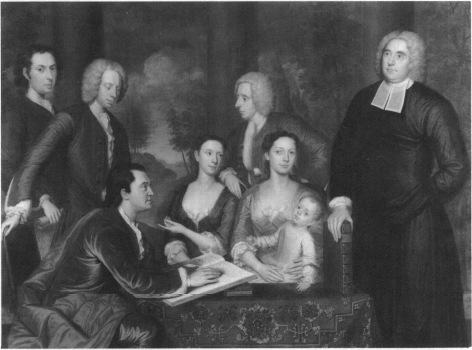
Fig. 281. Dean Berkeley and his Family, a group portrait by John Smibert, North America, 1729.
Cleaning also revealed that the artist worked against a dark grey ground and that the hands were executed in at least three widely differing techniques. Treatment brought back the clothing colors, with the exception of the green in a coat at left which had suffered permanent chemical change.14 The treatment did not, however, uncover any new markings or other surface clues.
Fig. 284. Detail from A Musical Gathering.
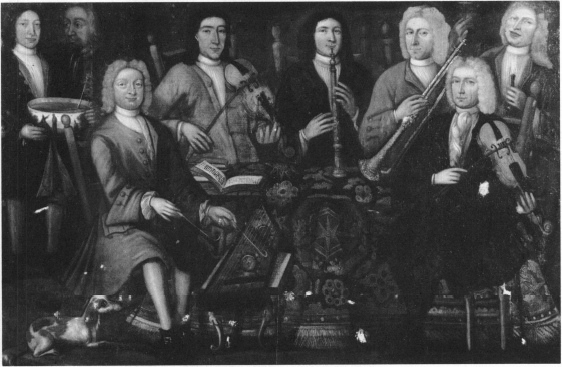
Fig. 285. A Musical Gathering before relining.
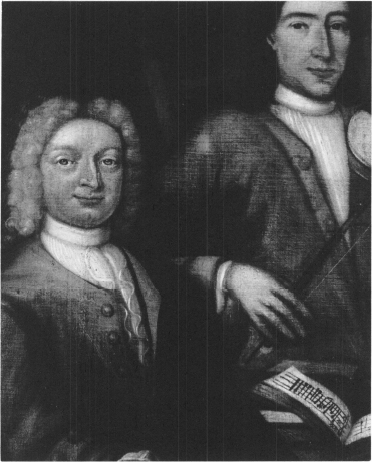
Fig. 290. Detail from A Musical Gathering.
Physical facts would now suggest that the painting was probably started by the 1730s, then altered, or perhaps finished, with more fashionable wig profiles in the 1740s. The new challenge was to suggest a provenance for the work corresponding to the earlier and more precise dating. Here the theme itself, the frank celebration of music making and drink, would strongly direct any New World attribution speculation to Virginia and South Carolina where there were fewer religious and moral restrictions on forms of entertainent at the beginning of the eighteenth century.
Particularly in Virginia, where Hugh Jones observed during his 1717–1721 stay at Williamsburg, “The habits, life, customs, computations, etc. of the Virginians are much the same as about London,”15 there was extensive knowledge and interest in art and music, entertainments, instruments, and collections of paintings and prints. Virginians, with their economy tightly linked to London tobacco wholesalers and shipping, had regular contact with English society through visits and schooling abroad.
It was here in Virginia, too, that the country developed its earliest popular social patterns of regular festivities, merriments, drink, and gay and raucous behavior, and it was here that there was the most widespread building of spacious mansions with large-scale walls suited to a mural-size painting. A number of these mansions, including William Byrd’s Westover and Robert Carter, Jr.’s Nomini Hall, had music rooms or ballrooms.
Inventories, letters, and newspapers reveal that taverns kept instruments for the pleasure of guests, that professionals arranged musical events in the early years of the eighteenth century, and that Virginia’s leading citizens such as John Randolph, John Blair, Mann Page, and Robert Carter were all involved with music and musical instruments.16 (It was also the Virginian Thomas Jefferson who recalled that he had been accustomed to spending no less than three hours a day on music!)17
Could the names lettered above the figures also belong to Virginia history? Perhaps, within a circumstantial context. One connection which also links a name with musical activities is the listing of a John Low with Peter Pelham, Jr., formerly of Boston, who had settled in Williamsburg as church organist ca. 1751. The two prepared the 1755 inventory of Cuthbert Ogle’s personal effects, which included instruments and an extensive music library.18 Ogle and Pelham were the leading professional musicians in Williamsburg, and it follows that one might assume that Low, too, was qualified to analyze the extensive collection of musical literature.
Ogle’s advertisement, published twice in the Virginia Gazette, for March 28, and April 4, 1755, indicates the existence of amateur ensemble performances. “The Subscriber, living at Mr. Nicholsen’s in Williamsburg, proposes to teach Gentlemen and Ladies to play on the Organ, Harpsichord or Spinnet; and to instruct those Gentlemen that play on other Instruments, so as to enable them to play in Concert. Upon having Encouragement I will fix in any Part of the Country.”
There are William and/or John Low family entries in Virginia land-holdings records dating back to 1635 in Charles City County and to 1704 in Prince George County. Notations of a Low family coming close to William Byrd’s circle of social, art, and musical activities occur in the Byrd Diary of 1709 in which the editor lists the Mrs. Low who owned land in Prince George County as Byrd’s after-church dinner guest, with Mr. Drury Stith, on May 29th. She then appears in Westover entries for the next two years. The Diary also mentions John Low discussing the shooting of game with Byrd on September 20, 1709.19
The Low land referred to would correspond to the two large plantations in Prince George County, Virginia, left to John and William Low, sons of William Low of Chowan precinct, North Carolina, whose will was probated in 1722. Two Emmanuel Lows appear in North Carolina records of the same area from 1711 to 1727. The North Carolina Abstract of Wills lists a George Low will of 1729 naming sons whose initials correspond to the Lows of the painting: John, Edward, and William.20
Acts of the Privy Council indicates a William Low was granted permission on March 13, 1705, for the Dolphin and Mermaid to sail from Bristol to Virginia. Other colonial records document a John Low receiving property in Lower Norfolk, 1675, and a John X. Low of Hanover and Henrico Counties receiving an estate in 1734. In 1756 a John Low was paid for service in the City of Prince William militia, and in 1758 a John Low was paid for militia service in Augusta County.21
The only correspondence to Joseph Rippingale, who carries the punch bowl, happens to appear again in Byrd’s Diary, when he writes on September 20, 1720, “Joe R——ng was very sick,” in a context that gives the impression that he is referring to a member of the Westover household.22
A few John Elliston entries appear in mid-century Virginia records, including one as a shipmaster and another as head of a family. It is a particularly difficult name to trace because there are many variations of the spelling. This foreground figure raises special question because of the “Esq.” following his name. The term was used in Virginia as in Boston to designate members of the Council and occasionally other officials.23 Further search into the Acts of the Privy Council for a possible connection reveals a “Mr. Elliston of Symond’s Inn” appearing before the Council in 1724 on behalf of the Randolphs of Virginia in a legal matter involving the Perrys of London, who were London business agents for many Virginians. Symonds Inn is described as an accommodation for masters of chancery, solicitors, and attorneys.24 In 1769 the Virginia Gazette carried a notice of the marriage of William Carter, aged twenty-three, and son of John Carter, to Mrs. Sarah Ellyson, “aged 85 with 3000 pounds fortune”!25
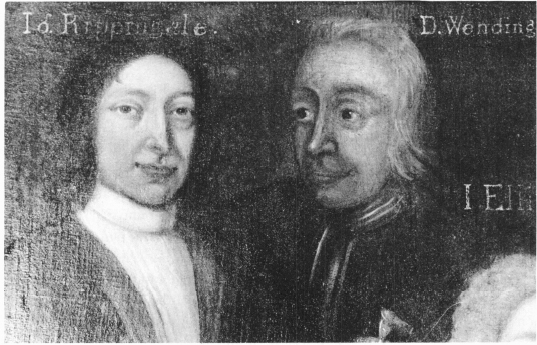
Fig. 291. Detail from A Musical Gathering.
Godbolt is a name that occurs in the North Carolina census of 1790 but only as Godbold prior to that. Both spellings of the name appear in early eighteenth-century South Carolina records.
Since Hale was a fairly common name in the colonies, it proved less conclusive in this examination. One entry with a corresponding first initial is a John Hale listed on the Rent Quit rolls in Virginia as having 900 acres in Essex County in 1704.26
Regarding the identity of Wending, the figure seemingly painted in after the others and in a different hand (fig. 291), there are no clues other than some possible correspondence with the Mr. Wendy who visited William Byrd at Westover in 1739 and 1740.27
Stylistically this figure suggests that speculation might be warranted concerning the involvement of William Dering, artist, musician, music teacher, and dancing master, whose name appeared frequently in the Virginia Gazette between 1737 and 1745 in connection with his school of dancing at William and Mary College and with the assemblies he gave in Williamsburg. His signed portrait of Mrs. Drury Stith ii hangs at Williamsburg (fig. 292).28 One other extant portrait, that of Mrs. William Randolph iii, has been attributed to Dering.
The Byrd Diary indicates that Dering was a frequent guest at West-over.29 Byrd’s own interest in music, dancing, and art stands out clearly in his diary and correspondence, and his impressive library is reported to have contained many bound volumes of music.30 Because of his London education and later lengthy time abroad he can be viewed as a colonist who would likely have known the tradition of the musical conversation piece.
Fig. 292. Portrait of Mrs. Drury Stith II by William Dering, Virginia, ca. 1740.
It was also on Byrd lands, but in Hanover County, Virginia, where St. Andrew’s Day music festivities occurred in the 1730s, a fact which could help significantly in suggesting a historical placement for A Musical Gathering. The Virginia Gazette for October 7, 1737, reported that a two-day fair was arranged with music contests and the awarding of a violin, comical diversions, horse racing, “handsome Entertainments . . . drinking to the Royal Healths,” and provision “that Drums, Trumpets, Hautboys and Etc. will be provided, to play at the said Entertainment.”
What seems to be characteristic of the many references to the popularity of using musical instruments at every level of life is that few players are mentioned by name. Some were amateurs, often referred to as “a number of Gentlemen playing,” and some were professional musicians, the itinerant “Professors of Musick,” who were usually regarded as persons of minor rank. It appears that the major southern landowners and heads of families are the only residents with considerable documentation. Few records exist for the bulk of the yeomen, ordinary citizens, and farmers. Unfortunately, many local administrative files were apparently destroyed during the Civil War.
Often, too, servants would furnish dance music. Investigation of the existence of indentured musicians, particularly white, suggests this was a common situation.31 In Virginia especially, a great many of the white men serving limited period indentures—often as repayment for pasage—came from Scotland.32 The St. Andrew’s Day music and entertainment was advertised particularly to “the Scots Gentlemen . . . partially to commemorate the patron of their Country.”
Sources such as the Virginia Gazette include numerous references to indentured musicians. Some, after serving brief indentures such as Charles and Mary Stagg, ca. 1716,33 and later Charles Love, achieved a degree of prominence. In 1757 a handsome reward was offered for the recovery of the run-away Charles Love, a white indentured servant described as “a Professor of Musick, Dancing, and Fencing.”34
An examination of the works of known artists who worked in the colonies, such as the Brodnax-Jacquelin limner, Bridges, Hesselius, Theus, and Kuhn, proved inconclusive. But there were also indentured artists and it became apparent that greater attention should be given to their possible contribution to the portrait oeuvre of the southern colonies. The disparity between the number of portraits painted in the late seventeenth and early eighteenth centuries and the number of identified portraitists has long been recognized as great. Before 1700 there is no artist recorded as having worked in Virginia painting Virginians. Between 1700 and 1750 only Bridges and Hesselius are known.
The emergence of any new name and any new evidence triggers wide art historical interest. Thus, it was exciting to discover the following reference in the Robert Carter letters for 1720 to his painter named “Cotten”: “[To Messrs. Micajah and Richard Perry] You charge me five pound paid to Cotten’s wife, my painter. He is very well satisfied with it and intends to send for his wife and child in to him next year. He’s really an honest, careful, sober fellow and may be able to get a comfortable livelihood when he comes to be his own man.”35 This letter deals with Carter’s experiences and requirements with regard to other persons of skill and leaves little doubt that the general theme is contract employment. Examination of the apprenticeship records of the London Painters and Stainers Guild showed no Cotten pre-1720, but several occurrences of the name in entries dated later. The Carter will, dated 1726, makes reference to “white Servants about my house that are tradesmen . . . be divided amongst my three sons John, Robert, and Charles . . . to be made use of as they shall agree in their respective trades.”36
Robert “King” Carter (1663–1732) had studied law and music and was, like his contemporary and in-law through marriage, William Byrd, a leading figure in the wealth, culture, and development of Virginia. About the time of the letter concerning Cotten, William Byrd wrote of “visiting Carter’s” for several days, during which “Mr. Stagg the dance master came. . . . we danced the minuet . . . and after dinner we danced again, French dances and country dances.”37 Two years later, the Carter Day Book for 1722 indicates he hired the leading musicians John Langford and Charles Stagg to provide “the musick” at his daughter Ann’s wedding to Benjamin Harrison.38
Carter’s portrait, part of the Shirley Plantation collection and probably dating from this period, has some stylistic similarities to A Musical Gathering. There is also an exact correspondence in the plainfront styling of the shirt.
Testing of a possible Virginia origin for the group portrait led to comparative study with hundreds of early eighteenth-century portraits, chiefly via photographs. There were similarities in Randolphs, Carters, Pages, Corbins, Hills, and in quantities of unidentified portraits.
Many ideas suggested by the photographs had to be altered when actual works were examined. The first stop on the research trip to Virginia, the Virginia Museum of Fine Arts, to see the Brodnax-Jaquelin portraits (1722, artist unknown) set the pattern of information. It was the portraits of the parents, one generation back and supposedly painted in London by Sir Peter Lely, that showed the closer parallel with the musicians’ portraits because of the chalky flesh color of the skin and decidedly blue cast to the modeling and shadows. In this comparison of course the Lely work is more accomplished and the costume is earlier. It was also in the earliest of the Boiling portraits at William and Mary that certain strong comparative qualities emerged.
Sifting and testing of stylistic parallels had to give prime consideration to the quality of brush stroke. While in so many instances the process of “restoring” was disguising, there was one close parallel to the musicians’ facial characteristics revealed by restoration. During its cleaning it was found that the ca. 1730 portrait (attributed to Hesselius) of Robert Carter, Jr. (1704–1731), was painted over an earlier portrait (fig. 293), which to this observer seems to be a copy of the Page family’s portrait of John Page by Lely, ca. 1666. Based on photographic comparisons, this head is very close in method of execution to the portrait of the musician Hale (fig. 290). Family records, unlike those of artists and musicians, are clear and accessible. Thus the chain linking these portraits can be theoretically traced through John Page’s son Matthew Page and his wife, Mary Mann Page, then passing to their son Mann Page (1691–1730), and his wife, Judith Carter. On the death of Mann Page, his brother-in-law Robert Carter, Jr., the subject of the over-image, became an executor under terms of the Page will.39
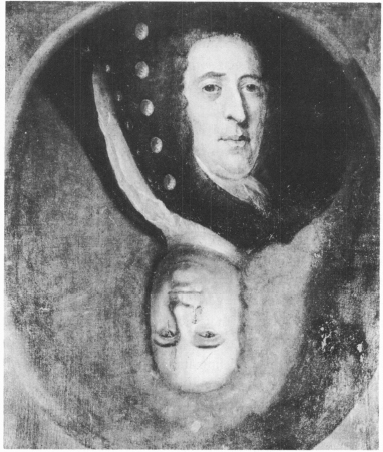
Fig. 293. Inverted head found under portrait of Robert Carter, Jr. of Virginia, unknown artist, ?Virginia, ca. 1730.
As the comparisons continued with the Boiling, Page, and other portraits at William and Mary, it became even more obvious that the whitish skin cast, blue shadow tone, and highlighting of nose bone that are present in A Musical Gathering were more typical of examples from the late seventeenth century when these qualities of style were popularized by London’s leading portraitists, Lely and Kneller. (The influential Kneller actually painted until 1723, and founded an academy in 1711.) The painter of A Musical Gathering apparently knew and was adhering closely to that tradition. In the handling of eyebrow, nose, eye, mouth, shadow, chin, jaw-line, and even the surface lettering, a version of the mannerisms of Kneller in particular is present.
The important evaluation of the chalkiness of skin tone and the presence of a direct, rough, vigorous brush stroke was complicated by the surface restoration and over-restoration through the years. There seemed little doubt that a zealousness to “modernize” any qualities that could be regarded, at various times, as “primitive” or simply as unfashionable, led to the disguise of significant aspects of the original. A “chalky” skin would be one of the easiest characteristics to adjust. The portrait of Elizabeth Hill is one of a unified group of at least five examples by an unknown artist in Virginia, ca. 1710–1720, that has bearing on A Musical Gathering, but it is the only one of that group hanging at Shirley Plantation that has not been out for restoration. Its skin tone, highlights, and general handling appear closer to those of the musicians.
The portrait of Mary Mann Page (1672—ca. 1728) at the College of William and Mary is one that has close similarities to the musicians in skin tone, blue shading, elongated nose highlight, and the pattern in the turkey carpet that covers a table at right. The portrait of her son, young Mann Page I, holding a cardinal, reveals hands that correspond to those found in A Musical Gathering, as well as a design pattern that suggests the directness and energetic inventiveness of the large composition. Rosewell, built by Mann Page, was the most ambitious mansion of its time.
William Randolph’s (1651–1711) portrait in the Virginia Historical Society is another that corresponds to the style of execution in A Musical Gathering. This also shows a similar rough stroke and similar coloring surrounding the eye. This and the Mary Mann Page example are part of the body of portraiture from the period that remains classified as “artist unknown.” That classification should also include many portraits bearing questionable attributions to Hesselius and to Bridges.
The “unknowns” who contributed to this colonial society included not only painters and musicians, but architects, designers, and builders as well. Inventories, wills, and other documents do not include makers, which is not all that surprising since the artist was still not considered much more than a special kind of skilled craftsman in decorative projects.
The question of attribution is a complicated one, with the majority of Virginia, Maryland, and Pennsylvania portraits painted before 1730 attributed to Hesselius even though some sitters were dead before the artist arrived in Maryland in 171140 and there is no real evidence that he was this active in Virginia. His style of handling, as much as can be determined through the restorations of the few works that can be assigned with certainty, does not tend to relate him to A Musical Gathering. He did, however, produce the mural-size Last Supper,41 mentioned previously, in which the figures fill the field with proportions and spacing resembling A Musical Gathering. The left background, too, has a structural division which recalls the painting of Mr. Wending at a point on the canvas that seems to have first depicted an architectural form. This construction treatment appears in other compositions of the early eighteenth century, sometimes in the work of the unknowns, but also in Smibert. It would appear to be derived from a Kneller approach.
Little is known of William Dering’s output, yet Philip Lightfoot’s inventory of Dering’s Williamsburg home, prepared in connection with a mortgage during the mid-1740s, lists twenty-seven pictures, framed and unframed.42 He had left Virginia by 1751, the date his property was auctioned. There are accounts that he was in Philadelphia as a dancing master in 1735, and in South Carolina as a painter in 1761.43
Still other artists are known to have worked in the colonies just after 1700 but so few, if any, works can be assigned to them that there is insufficient material for any study. The Scotsman John Watson worked in New York (where the Low name occurs) and New Jersey (a John Low was living in Newark in 1749). Nehemiah Partridge in 1718 and Raphael Goelet in 1724 were also known as New York limners. John Winter lettered canvases in Philadelphia, as did an artist named Chambers in New York. Philadelphia also had Christopher Witt, Peter Cooper, Peter Luolie, Aaron Huliut, and Samuel Johnson. Walter Wallace came as an indentured painter to South Carolina, where B. Roberts had been working, and J. Cooper painted the unidentified Man with Violin. (See fig. 430 in Cynthia Adams Hoover’s contribution to this volume. Could this unusually small work have been cut from a multifigure composition?)
Because physical and New World genealogical investigations do not conclusively place A Musical Gathering in America it seems wise to review English genealogical correspondence with the hope that others might be able to supply further information.
It was in pursuit of a John Elliston identification that the most promising data for speculation came to light. Two prospects occur in genealogical records. One is the John Elliston of Overhall Manor, Essex, England, who is listed as having inherited his father’s estate in 1691, at the age of thirty-two. This is a lineage in which the “Esq.” was used.
The second John Elliston ([?1680–1745], son of John Elliston of West Mailing who died in 1707/8) was the brother of Martha Elliston (1687–1743) who in 1702 married the portrait painter Richard Philips (1680–1741) of Great Queen Street, London. Their son was the Charles Philips (1708–1747) who achieved fame in London as a painter of large group pictures, and who probably painted the Williamsburg Family Group (fig. 280). While the younger Philips is far too sophisticated an artist to be responsible for the musicians’ painting, Richard Philips, who was a milliner before turning to portraiture, seemed to be a possible candidate.44 Photos of a few of his works suggest, however, that his work, too, has more sophistication than A Musical Gathering.
The genealogy indicates Charles Philips married Mary Freeman of Antigua in 1738. Their daughter Martha (1742–1801) married Richard Jones. Published records of this family show an 1870 genealogical contribution by Thomas Whatman Jones, who attempts to explain a dispute involving “Mr. James Whatman who came to the funeral of Mrs. S. E. Philips, an aunt by Marriage, and swept away all that had belonged to Mr. Richard Elliston Philips . . . [He] took pictures, and documents.”45
The name “R. Godbolt” does not occur in that spelling, but as God-bold. A Richard was born in the late seventeenth century to the owners of the estate of Toppingo-Hall, Essex, and another in the same family line ca. 1700–1710.46
A Rippingale appears in Surtees Society publications as a resident of Lincolnshire in 1563/4, and a Rev. John Rippingall has an obituary notice in London in 1769.47
The quantity of Low families makes this a more difficult identification to establish. A “landed gentry” family of Lows does occur, however, in the northern English city of Chester with brothers William, Joshua, Edward, and John who would have reached maturity in the early eighteenth century. A different William Low is listed in the records of the Painters and Stainers Guild for 1740 as having received an apprentice for seven years.48 Thus, with the idea of an English origin not encouraged by British specialists, the question remains open.
If the Virginia background were to be accepted, the matter of the Connecticut auction discovery would possibly relate logically to eighteenth- and nineteenth-century mansion disassembly. Various portions of the contents of Westover, for example, including the library and music hall building, were turned into needed cash before the Revolutionary War. The furnishings of Rosewell were dispersed, and the mansion left the hands of the Page family in 1838.
While there are many avenues for circumstantial speculation, a single specific hypothesis or a definite resolution will have to await hoped for but as yet uncovered documents. Meanwhile, A Musical Gathering is a welcome reflection of the styles and traditions that gave birth to America’s early landmarks in colonial painting and her social music practices.

 PHYLLIS BRAFF
PHYLLIS BRAFF
